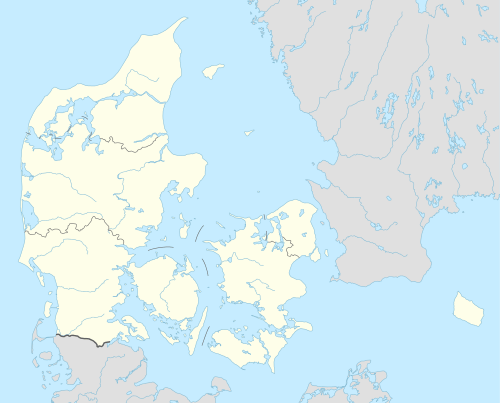Jelling
| Jelling | |
|---|---|
|
Former sign of Jelling Municipality | |
 Jelling Location in Denmark | |
| Coordinates: 55°45′13″N 09°24′54″E / 55.75361°N 9.41500°ECoordinates: 55°45′13″N 09°24′54″E / 55.75361°N 9.41500°E | |
| Country | Denmark |
| Region | Southern Denmark (Syddanmark) |
| Municipality | Vejle |
| Established | 636 |
| Elevation | 344 ft (105 m) |
| Population (2014) | |
| • Total | 3,370 |
| Time zone | CET (UTC+1) |
| • Summer (DST) | CEST (UTC+2) |
| Website | |
Jelling is a village in Denmark with a population of 3,370 (1 January 2014),[1] located in Jelling Parish approx. 10 km northwest of Vejle. The village lies 105 metres above sea level.
Location
Jelling is located in Vejle municipality and Region of Southern Denmark. The town is mainly famous for the Jelling stones, national monuments. Until Municipal Reform 2007 1 January 2007 Jelling was the capital of Jelling municipality. Jelling was also the only town in the former Vejle County headquarters for a bank – Jelling Sparekasse, which had its headquarters in the town until 2007 when it merged with Den Jyske Sparekasse, headquartered in Grindsted. Jelling Sparekasse's slogan was: "If king Gorm was alive today ... we would probably be the country's National Bank."
Infrastructure
From Jelling it is 56 km to Herning and Silkeborg, 80 km to Aarhus and 10 km to the regional capital Vejle. Jelling is close to the Østjyske Motorvej – (E45) and Midtjyske Motorvej – (Primary Route 18). The railroad track Herning – Vejle goes through Jelling.
In 2003 Jelling municipality was the first municipality in Denmark to offer its residents wireless Internet connection, up to 4 Mbit broadband, at a distance of up to 10 km from Jelling.[2]
Town centre
Vejle municipality is working to execute a master plan in the village centre. The plan is to redirect traffic in Jelling, and close Gormsgade, which today is part of the main road (Secondary Route 422) in the town.[3]
This master plan will cost in the neighbourhood of 250 million DKK (33,5 million €) which include financing described by The State of Denmark, Vejle municipality, Haderslev Diocese and other private foundations, among them "AP Møller and Chastine Mc-Kinney Møller Foundation for General Purposes" – which has donated 70 million DKK (10 million €) for the project.[4]
History
Jelling is an old and important historical town in the history of Denmark. In the Viking Age it served as the royal seat of the first Monarchs of the Kingdom of Denmark. Jelling is the site of a large stone ship and two large burial mounds, the Jelling stones and Jelling Church which are an UNESCO World Heritage Site since 1994. In the North Mound, built between 958 and 959 CE (possibly for King Gorm of Denmark), an empty burial chamber was found. The South Mound was built around 970 and contains no burial. Beneath the two mounds is a large stone ship from around the end of the 9th century. Between the two mounds stands two rune stones, the Jelling stones. Near the stones, Gorm's son King Harald Bluetooth built a wooden church (965), and beneath it re-interred (965–966) the remains of his father.
Local culture
The Jelling Music Festival is held annually and is currently Denmark's third largest festival. Bredagerskolen (situated in Jelling) is the largest school in Vejle municipality. The school currently has 810 students[5] (2009) divided into 0–9 classes over 2–5 traces. The village houses the CVU Lillebælt, which trains teachers and educators. There are three grocery stores in Jelling, two gas stations, three garages, two banks, two breweries, and some other stores. The newly opened town house is to house Borgerservice, a library, a cinema, a café, and one of the two breweries.
References
External links
| Wikimedia Commons has media related to Jelling. |
 Jelling travel guide from Wikivoyage
Jelling travel guide from Wikivoyage
